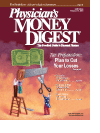Publication
Article
Physician's Money Digest
Look Sharp, Protect Retirement Plans
Author(s):
I f you are like most physicians,you have probably seen yourpension or IRA balance dropsignificantly over the past 2 years.The market has probably been drivingyou crazy. You have probablyasked yourself the following question:"Will I ever recoup my lossesor will I die with a much-depreciatedretirement plan balance?"
If you absolutely need all of yourretirement plan assets to support yourquality of life in your golden years,then you have to stick it out with theinvestments that are available to you.If you can support your desired qualityof life with 2% to 4% money marketreturns, then you shouldn't subjectyourself to any unnecessary risk.Why jump back into the market ifyou don't have to? Unfortunately,many physicians look at investing asa "zero-sum game"—if you don'twin, you lose. That couldn't be anyfurther from the truth.
If you have enough to supportyour retirement, then why are yousubjecting your retirement to risk? Ifyou get 8% annual gains instead of4%, how much more will you reallyspend? Do you think that if you get alarger return on your investments inyour retirement accounts that youwill be able to leave more for yourheirs? If so, guess again. Did youknow that your retirement plans andIRAs will likely be taxed at rates of70% to 80% when you die?
That's right. Your heirs will have topay income taxes and estate taxes onthat money. If you consider that theestate tax rate quickly rises to 50%and most states have a combined federaland state income tax rate of 45%,it is easy to see why a $1-million pensionor IRA balance at death will onlybe worth $212,000 to your children.
When most doctors get over theshock of learning how worthless theirretirement plans are to their children,they generally search for ways toavoid this unnecessary tax. First, youmust get over a few common misconceptionsmost people have about retirementplan and IRA assets. Themoney in the plan is not yours. Justover 50% of what you see in your balanceis yours—the rest belongs to theIRS. Furthermore, the balance inyour retirement plan or IRA is onlyworth 20% to 25% to your kids.
Armed with this knowledge, youcan move on to step 2. If you plan toleave any money to your heirs by wayof an inheritance, why don't you doyour estate planning with the mosttax-disadvantaged assets you have?Most Americans do their estateplanning with after-tax dollars thatwould otherwise have been worth50% to their children. If you coulddo your planning with the pretaxdollars you have, then you might beable to get the government to fundhalf of your estate plan—wouldn'tthat be a nice change, them helpingyou? How do you do that?
Consider the capital transformation strategy (CTS). A recent Departmentof Labor notice clarified previouslyunknown facts about doingestate planning with retirement planassets. We now know the following:
- You can purchase second-to-dieinsurance in your profit sharingplan with pretax dollars.
- A trust that you create for yourchildren can purchase that policyfrom your plan with no income taxesbeing due by either party.
- The price the trust must pay forthat policy is the cash surrendervalue, which may be only 20% to35% of the amount you paid for it.
This may all seem like a great dealof confusing information for you, butlet's look at the benefits that 3 differentdoctors have realized for theirfamilies by using this strategy.
Case 1: Dr. Paul James, surgeon,66 years old. Dr. James used$3 million of retirement plan assets.He realized that the $3 million wasonly worth $600,000 to his children(after both taxes would be paid). Byutilizing the CTS and through making3 years of annual gifts to a trustfor the benefit of his children andgrandchildren, he was able to create$10.3 million tax-free for his family. Ifhe and his wife live 3 years past theirlife expectancy, the after-tax benefitwill be in excess of $7 million.
Case 2: Dr. Gail Logan, gastroenterologist,55 years old. Dr.Logan and her husband, a 58-yearoldinternist, had $500,000 of retirementplan assets they thought theywould never need. They realized the$500,000 wasn't worth much to theirchildren, and they were intriguedwith the idea of using the most tax-threateneddollars to do their estateplanning. They were able to covert$500,000 of 80% taxable assets toover $5 million tax-free for their heirs.
Case 3: Dr. Chandan Patel,anesthesiologist, 62 years old. Dr.Patel had already done his estateplanning. However, he was concernedthat his wife would outlivehim by many years, and he wanted toprovide for her. He realized that$480,000 of retirement plan assetswere only worth about $250,000 toMrs. Patel after she paid incometaxes. He implemented the CTS andturned $250,000 into $2 million tax-freeto his wife at the time of hisdeath. This number would have beenhigher, but Dr. Patel had a medicalcondition that had an adverse effecton his underwriting. Had he beenhealthy, he may have been able toleave over $3 million to Mrs. Patel.
If you have lost a great deal ofmoney in your retirement plan, areinvesting in your retirement plan withthe hopes of leaving it to your heirs,or you just want to implement themost efficient estate planning techniquesto benefit your family, youmay want to implement the CTS.Ideally, the plan works for familieswith over $500,000 in combined planbalances who also have a net worthabove $2 million or for anyone withplan balances over $100,000 who areworth more than $5 million.
After the Department of Labor'sannouncement, products from someof the premier insurance companiesin the country were released. Considerthe CTS only with very strongAAA- or AA-rated companies.
Christopher R. Jarvis and
David B. Mandell are authors
of The Doctor's Wealth Protection
Guide and Wealth Protection:
Build and Preserve Your Financial
Fortress (just released in November
2002, you can read reviews and sample
chapters and purchase the book at a 20%
to 30% discount at www.mywealthprotection.com). They also started the financial
firm, Jarvis & Mandell, LLC, and work with
clients nationwide. They welcome questions
and comments at 888-317-9895.
